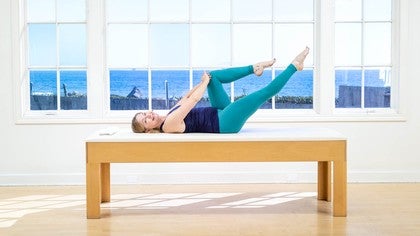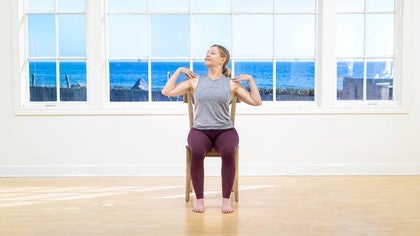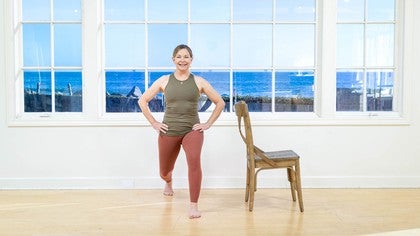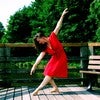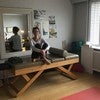Description
About This Video
Transcript
Read Full Transcript
Hi, my name is Amy Havens. I'm here with Pilates Anytime to offer my third class of four in a series. This class is called Feet and Knees, keys to stability and balance. So all you're gonna need for this class, again, is a chair and a towel and I'll show you what to do with the towel in a few minutes. And as always, be sure to consult with your doctor before starting any new exercise regime.
So feet and knees, the keys to stability and balance. It's quite true. If we have solid feet, grounded feet, good alignment with the feet, good alignment with the knees, we're more likely to have pretty solid balance, but that's not everybody's truth. Everyone has different alignment of their legs, different alignment of the feet and that can alter our sense of balance and stability. So there are some ideal alignments that we work with, but again, not everybody has those ideals, and I'll break those down in just a minute, but what I want you to do, everybody, first, is just stand with your feet apart.
Look down at how you're standing. Don't change anything. Just notice how you're standing, okay? And I'm looking at my own feet and I see that my toes are forward. My knee caps look like their forward and if I were to bend my knees, my knees would point forward.
What do yours do? So some of you might do that and your knees might do this angle and come in. Just notice if they do. If you bend your knees and your knees do more of an outward angle, just notice if they do. Okay, we're gonna talk about that in just a minute, but what I wanna focus on is, just reminding you that everyone's alignment is theirs, but there are some ideals, okay?
And the ideals really have to do with how we load the joints of the body from the hips to the knees, to the feet. How we strengthen all the muscles around those specific alignments for ideal alignment and posture and how we support the bones and the joints with those muscles, okay? So some of you may or may not be able to make these changes that I'm gonna show you, but I think with a little finessing, we'll be able to get there, okay? But let's warm up a little bit and we're gonna wake up and I love starting foot-centered and knee-centered classes with the feet and awareness of the feet. So what I want you to do again, we're gonna start, again, with the feet.
Look down. Now, if you had your toes open before, I'm going to ask everybody to do this with their toes straight ahead. Okay. And then we're also gonna try to take those leg bones, these thigh bones and again, if they were here, let's see if you can make them a little more aligned out this way straight. See how I've got that and how my knees aren't knocking together.
Okay, see if you can maintain that. And also if your knees were open, you're gonna try to angle them a little straighter. And as you do that, you might start to feel some muscles of support around the top of your leg, around your buttock. That's good. Okay, see if you can feel that.
Now, we're gonna lift the toes and I really think like the pads of my toes. All 10 toes lift up as high as you can. Usually, most of us wanna look down to do that, so go ahead, look down, see that all 10 toes are up as high as you can and then lower the toes down. And let's do that again. And lift all toes up.
So this is part of awareness building. We've got lots of nerve endings at the bottom of our feet and so by lifting, by waking up, by you doing these little foot exercises, we're actually waking up those nerves and the proprioception of where we are in space. When we're talking about balance, which we are, we really need to have an awareness of how we are in our spatial area, okay? So keep lifting and lowering, we'll do a couple more. Lift those toes, try to get as high as you can, a little higher and lower.
And then one more time and lift, lift, lift the toes. Okay now, as you lower your toes down, just feel what you might feel around the arches of your feet. Okay, the arches of your feet. And then let's take one more little assessment just quick. If you look down at your feet, I'm gonna just show a little bit from the side, feel that dropping of the ankle, that turning of the ankle.
So from the front view, it kind of looks like that. That usually might, that could show up often too if you're the knock-knee person, it's okay. Or if your feet are rolling out this way, if your knees are pointed open, we're gonna try to strengthen that and minimize some of those angles, okay? So once again, let's re-establish that straight ahead place. Now, just right parallel for you and do two more of your heel lifts and focus on your ankle also not rolling in or rolling out.
One more time, toes up and toes down, okay? Good, now, moving, I'm gonna do, this is my right foot that I'm tapping here, my right leg, I'm gonna lift that heel up and I'm rolling up onto the ball of my foot. I'm gonna refer that as a metatarsal arch or transverse arch. And I want you to mobilize your foot, everybody, really get up on the ball of that foot and put the heel down. Let's do that eight times.
So rock up and rock down. And what I want you to feel here is a little pressure of your foot into the floor and as you're doing this, you're already starting some fundamental principle of alignment, of tracking your knee straight in line with your second toe, okay? So again, we're gonna try to keep these real parallel lines of alignment one more time. And avoid some of this inward, outward of the thigh right now, okay? Other leg.
So rolling up onto the ball of the foot and rolling back to the heel. Rolling up, pressing the foot slightly into the floor. Mobilizing through those metatarsal joints. Tracking you knee straight ahead. And four more.
So although I'm saying tracking straight ahead, in just a minute I'm gonna throw us a curve ball. Okay, last two. Excuse me. And your last one. That's just rolling up on the ball of the foot parallel.
So important to be able to do that without rolling off the side of the foot. That's where we lose our balance sometimes, right, and trip and fall. We don't wanna fall. No one should fall. Okay, but now let's just challenge this a little, go to that first foot again.
Okay, now roll side to side across the metatarsal arch. See if you can do it mainly from your foot bones and the ankle bone, not so much from your thigh bone. Okay, a little may happen from your thigh bone, but I'd really like to see if you can do it from your foot and ankle. A few more times. So again, we do a lot of mobilization before we do strengthening principles, at least I do.
Okay and then change feet. We're also creating a nice wide base of support in your foot. Key to balance, you want a nice wide base of support, okay? So try to rock and move across that transverse arch, mainly from the foot bones and your ankle bone, not so much your thigh bone. All right, one foot might have more coordination than the other one, pretty normal, but you're stretching some muscles, you're opening joints, you're bringing awareness, you're strengthening muscles and feet and ankles.
Who can feel their calf muscles kicking in? I can. Yeah, okay and then come back down. Now, you might even see that your feet are wider, mine sure do, they've widened up down there. Now, that's a better environment to stand up on a little tiptoe.
So I'm talking like an inch or two guys of lifting your heels, so tiny and lower. Just pressing the balls of the feet into the floor and the response is the heels will lift. It's pretty tiny. Okay, let's think about the alignment. Where are your ankles?
Can you be balanced on the ball of the foot and not roll? I'll show a rolling one. Try not to, let's avoid that. Okay and we'll avoid this one. Rolling in.
We're gonna see if we can stay real parallel there. Three or four more. Shoo, okay. Yeah, last time. Now, I want you to take that first foot that we did, this one here and we rolled the ball of the foot.
Now, I want you to do something, I call it a flick, I just kind of flick my foot. What is this for? Well, when we have a, I'm just gonna keep doing it, when we are working on balanced concepts, we need some agility work too. Agility is usually kind of speeding things up and changing direction. That's good for response time and response time is really key when you're talking about balance.
You wanna have pretty quick response time, so you don't trip and fall, okay? So let's say we're done with that foot, let's do the other side. And if you're at home or you have kids at home or you have grandkids, how many toys have you almost stepped on or dog toys? I have a dog, right? And all the toys are around and you step and you almost take a tumble.
So these types of little quick movements can be training exercises, little drills, to keep your sense of agility and quickness, okay? Go from foot to foot and go kind of quick with it, right? Yeah. And you're gonna notice your muscles in your feet working. Five.
Four. Three, looks like a little march, two and one and then just pause. Wonderful. Now we need our towel for the next exercise, okay? So guys, here's your towel and I want you to first folded in half.
We're gonna make it a little log roll. All right, so I'm gonna roll it up here. We're about to stand on this towel. Okay. So I want you to put that towel on the ground.
Boom, just like that. It's not a real big lift up off the floor, but just having a tiny bit more height of us off the floor, your nervous system is gonna be responding a little bit and you're gonna sense a little bit of instability. So as we step up on this towel, let's talk about parallel again, okay? So here's what I'm doing. I'm gonna start with this foot.
And I'd like to have that foot in front of the other one slightly. You can see how I'm a little staggered in my stance. And I'd like you to bend this knee and just slightly weight shift, everybody, slightly weight shift forward and I want you to focus on how that knee is tracking over that second toe, okay? As you're weight shifting, push down on the towel. I like to imagine that this is like a wet sponge and I'm trying to squish all the water out of the sponge.
So you really have to push down. And what that does, it starts to give some muscle work up into your leg, your glutes, your hip, okay? Now, slide it back a little bit, we're gonna stand on it. You're only a couple inches off the floor, but what happens, because the towel is a rolled surface, a round surface, your ankle is gonna have to navigate something different than a flat surface, okay? So let's give it a try.
Can you take the other foot off the floor a little bit? Oh boy and I just do this with my hands. It makes sense to me. If you need a hold on your chair to do this, you could certainly hold on to your chair. But what you're gonna notice, is that ankle is doing lots of little wiggles and wobbles.
Let them all happen first, okay? Let them all happen. These are fall prevention moments. Your body is going, whoa, I don't wanna fall and your body's preventing a fall. Isn't that weird?
We have to put it in a fall prevention moment before we fall. I'm gonna put my foot down and then just stand side-by-side and feel the difference between the leg that got the work and which didn't, okay? Time for this side, so here we go. Fluff your towel back up and we have this weight shift. So one foot comes up on it.
The other foot stands back a little bit. All right. You're tracking your knee, kneecap, center of it, out over that second toe. And I'm encouraging you to shift pretty far forward. Can you tell how I'm doing that?
I'm sneaking something in. Really shift some weight. Let that knee come forward over those toes. All right. That's really functional work.
You're gonna see more of that in class number four also and later in this class. Getting that ankle to have more motion. All right. Now, standing on the towel. We wanna be tall.
Think about all the posture work we've been working on in the first two classes and there you go. So now you're putting your body in an environment of instability. What did we talk about in class number one? Stability, right? Use your core muscles in here.
Pull your tummy in. Stand tall in your spine and let those wiggles happen. Let the wiggles happen. Yeah, we're doing fall prevention exercise right now. Again, if you feel unsteady, just put your hands on the chair and then step down.
Okay, we're not done with that yet. Step here. I want you to go to the first foot one more time. We're gonna give each foot another turn and think about something a little different this time as we step up. To have a little more success in the feeling of balance and steadiness, the word I like to use for my foot is stiffen or brace or stabilize.
And I'm gonna use that word in my brain and send it down to my ankle and I'm gonna try to stiffen my ankle or stabilize my ankle, so that I wiggle a little less. Yup and do you feel different muscles around your leg, ankle, foot? Probably, maybe up into your hip. Let's try it for about two more seconds there. Okay, try the other side.
You can fluff that up in between each one. So on the first round, we allowed the wiggles for a reason. The second one, I'm trying to stabilize the wiggles for a reason, for stability, for a little better balance. A different type of balance training. Try to stiffen.
Yeah. Feel the different muscles activate when you change the goal of the exercise. Now, your knee might be moving a little bit, we're about to talk about that. This is a tough side for me today. Okay, I think we made our point.
All right, nothing perfect about that, that's just an exercise. We're done with our towel, so you can just put that away. All right. Let's talk more about knee alignment. I was talking about it at the beginning, of this internal angle, this knocking in or this bowing out.
And some of you have natural alignment like that, it's okay, but when we do bigger loaded exercises, which we're about to do, load meaning strength work, I really wanna focus on the alignment from the knee to the foot and how that really serves better balance alignment, okay? So we're gonna turn the chair. I am gonna have you use your chair and I'm turning it sideways. And I want you to have a pretty wide stance between your two feet. Okay, pretty wide stance.
We're gonna check into what this is all about here. Now, as you have this wide stance, my request for you is that you have this heel down, so you feel the stretch in your calf muscles and down into the bottom of your foot there. If that's not available for you, you step into where you can, okay? But some of you can go pretty far. So you'll see me try that one and we're gonna work on two straight knees.
Good alignment, we already know what that feels like and contract your glute muscles, everybody. Put your hand on your rear end and make it firm up. You gotta squeeze it. You gotta contract, okay? So I want you to feel now, the power here, press your ball of your foot, we did that a minute ago, into the ground and how that heel rises up, right?
And you might feel some wonderful stretch right here through the front of your hip and then I want everybody to lower the heel down and we're going to do that again. Press and lower. With two straight knees, press and lower. Really use the ground, press. Now, if you don't need the chair, don't use it, hold your arms out somewhere else.
You could have them right in front of you. You could have him reaching up a little bit. You could have hands behind your head. Notice how all of those challenge your steadiness and balance, right? Two more times.
And last time, holding, I am gonna use the chair now, I'm gonna put my hands down, okay? We're about to load our legs more. Leg strength is important for balance strength. Bend both knees, very small. Look at your front leg, everybody, and it should be tracking right out in front of that second toe.
Okay, back heel is lifted. This knee is pointed straight down to the floor and then straighten both knees. And we'll go down with two knees and straighten both knees. About five is all we need to do, we don't have to do a lot. Okay.
Now, the tracking is what I'm after here, the tracking of my knee parallel, straight ahead. And then one more time, let's hold. Let go and just hold. Feel your balance. Feel your balance, feel the alignment and how that's helping to stabilize your balance.
Hands on your chair. Now this back leg, I want you to step it in just a little bit and take a shorter stance. Take a shorter stance. Can you get the heel down, knee bent and track your knees parallel, and just hang out. Feel the work in your ankle.
Should be deep ankle flexion right there, okay? Nice. Other side. I'm gonna turn my chair. Got that split stance.
Really important to have a nice wide support if you can. Big, beautiful stretch in your hip. Pull those abdominal muscles up, contract your glutes, okay? And then here we go, everybody. You're pressing the ball of the foot into the floor to lift the heel.
And we're also working parallel on this. So I talked a lot about the knees, but it's the foot and the ankle also. We don't wanna roll that ankle. Ouch. That would cause me to fall that way maybe.
I don't wanna roll my foot in, ouch, okay? So parallel, lift. Lower, this is really great, if you have a mirror to do this in front of next time to be able to watch yourself, it's such a good tool to use, 'cause how do you know? Sometimes you don't know, okay? Let's go for more, contract those glutes, press into the floor.
Knees are nice and straight. Press and lower. Trying to get that heel down. Getting that deep flexion in the ankle joint. One more, we're holding here.
Now, the little knee bend. I'm not taking us too low today. We could go lower next time. Try to get your heel up. Get on the metatarsals, there they go.
Track your knee forward and then straighten both legs. We did that five times. Five is plenty. Concentrate on your alignment. Keep that back heel lifted.
Three more. And two more. Okay, we're about to, oh, about to challenge our balance, right? Let go. And just hold that.
Hold that. Good and hands down. Now take that back foot and do a shorter step. Still posture upright, head over shoulders over hips and focus on how much bend you can have in that ankle with your heel straight behind you, knee focused forward and just hold. Aah, important to keep those ankles very flexible, very strong.
And then, everybody, just stand on two feet for a moment. Okay, good. So now join me for this. We're gonna do a little lunging, okay? And this is where I'm gonna talk about the knee going a little farther than where it just was if you can.
I'm gonna step outside or forward with this inside foot here and I want you to take a pretty big step. Pause right there. So notice, I'm gonna send that knee again, straight out over that second toe, but I'm actually gonna increase where my shin's going. My shin's also going a little bit farther forward, okay? That's challenging my steadiness quite a bit.
And then push yourself backward. Push back. Let's do that again on the same foot. Take a chance, how far can you go? We really wanna land the leg parallel.
That's tricky. And then push back. I'm gonna try it without the chair. Whoa, I did. I did pretty good, and push back.
How about two more? We don't need many. And it's okay to feel a little unsteady now and again. These are practices, right? These are drills, these are exercises.
Yeah. And in, other side, so here goes this foot. I'm gonna use this a couple of times. Land, there's that big bend in the ankle, big bend in the knee and push backward. And step in lunge and push back.
Three more, without the chair if you can. And in. And two more. Feel how that load of the leg, concentration on the alignment, really works your balance. Okay.
Now, just standing side-by-side feet, I want you, we did at the very beginning some heel lifts, I want us to do bigger lifts now with the heels, we're plenty warmed up. Take both feet, press into the ground and get your heels as high as you can bring them with good alignment, right? So again, we're trying to not have this angle or this one. Ideally, the heel should be straight back behind the ankle and then we'll lower and we'll do up and down 10 more times. Press and lower.
If you don't need the chair, you can let go. Keep the base of the feet really wide. Five more times, one and two. We'll stay up on the fifth one. Three.
Four, here we go. Staying lifted now. I want you to bend one knee. Woo, put the other heel down. Where is it tracking?
Straight ahead. Go up and alternate. We've been here before several times. Up and alternate, so it's a treading motion. You can go ahead and let go and then just pick up your tempo a little bit, okay?
By picking up the tempo, you can feel how your balance is challenged. You can try closing your eyes with that if you want. You can keep going and turn your head a little bit from side to side. Keep the alignment of your knees and feet parallel. Let's go five.
Five. Four. Four. Three. Two and one and all the way down.
Okay, real quick and dirty. Pick up a foot. How do you feel on that balance? Pretty good? Put down that foot and pick up the other one.
Pretty good. This is kind of low-level balance challenge. Let's do each side again. Stand on that one foot. We're gonna do a little game here in a sec, okay?
Step on the other foot. I want you to get your towel. I dropped mine over here. I'm gonna bring it back in and I really, I don't know, just maybe put it right there. Just drop it.
So challenge yourself, your chair's here if you need it. Step up on one leg, put this leg up here. Now, let's start making a goal. We're gonna try to get down and pick up the towel. We'll see.
Can you get down there and pick up that towel? I'm gonna reach for it and pick it up. What if I don't hold on. I can drop it from here, but I'm gonna ask you to place the towel on the ground. Try to keep those knees pointed straight ahead and toes pointed straight ahead, okay?
And then stand on two feet for a second and let's try the other side. And leaning forward, trying to go down and touch that towel or pick that towel up. Come all the way up. You're still standing on that single leg and then putting the towel back on the ground again. Now, if that is not working for you, don't worry, that's a really tough one.
I'll show it without. You can just in the direction of the floor, okay? You're going toward that floor and picking that up, changing feet. Lifting and changing. You're trying to get down to the ground.
You've done all those ankle motions and those knee bends. I'll do one more again. Picking that towel up. Putting it back down. Changing feet.
Keeping your balance as steady as you can, knees forward, toes forward and putting it down. Okay, more on all those later, but let's do one more drill, one more little exercise. So stand back a little farther. This is known as a tandem walk or a tandem step. I'm gonna do about four steps.
Move your towel so you don't step on it, okay? So you put one foot forward. Ball of the foot in line with the heel and then take the other foot and put your heel right in front of your big toe and then stand on two feet here. Now, if you're more prone to knocking your knees together, you're gonna feel that pretty quickly, the knees touching. So see if you can widen your knees a little bit.
You may feel some muscle work in your hips and your buttocks. Let's see if we can get 50% of our body weight on each foot and just hold. Feel our steadiness. Look forward and spot something with your eyes. Okay, now we're gonna take the back foot and come forward, heel to toe.
Right in front of that foot. 50% of the weight on each leg. Now, if you're the open knee person, like that, try to bring the knees a little narrower. If you're more of a neutral leg alignment, like I've got it, feel steady. We're all working on balance here and the relationship from our feet to our knees and to our hips.
Let's do one more each foot. So heel to toe. 50% of the weight on each foot. Okay, there it is. And then one more, heel to toe.
50% of the weight on each foot. We should walk backward at least one step of each. Let's see what happens when we walk backward. Front foot behind, toe to the heel. 50% of your weight.
Focus with your eyes. Feel the feet broad, kneecaps forward. And then one more, we'll go this way, guys, toe to the heel. Where's my heel? There it is.
Yeah, steady, steady, steady. Good. And then two feet together and then just stand really still. We've done lots of things that challenge that sense of balance. Front to back, side to side.
Let's take a couple of deep breaths. We've done a lot of balance work today. We focused a tremendous amount of alignment, the relationship of our feet to our knees, to our hips. Really wonderful work. I wanna thank you so much for joining me today for class number three.
Active Aging: Active Aging with Amy Havens
Comments
You need to be a subscriber to post a comment.
Please Log In or Create an Account to start your free trial.
